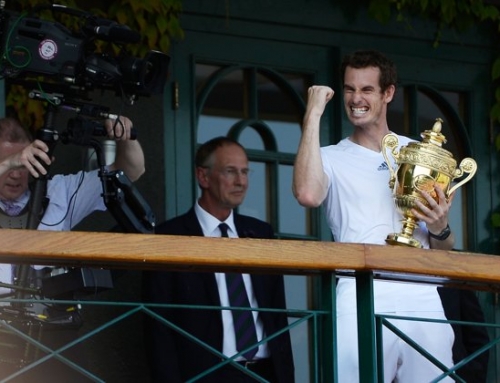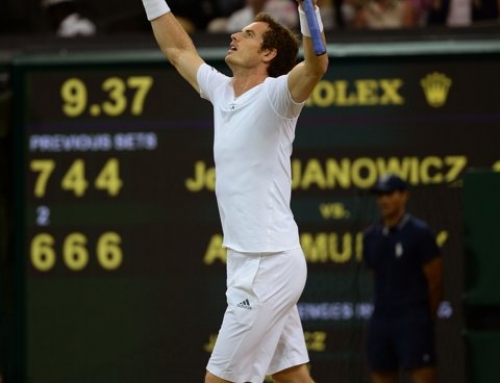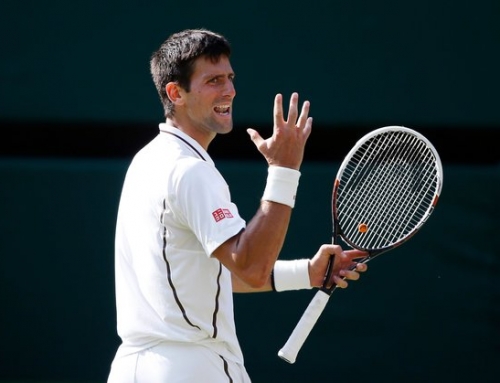
The grass court season is pretty much non-existent these days, a fallout of the US Open first changing its surface to clay, then to grass, back in the mid 70s. For most players, the grass court season consists of three tournaments: Queen’s, Halle, and Wimbledon.
Since Queen’s and Halle are played the same week, players can only play on one. Most of the top men elect to take the week off before Wimbledon to prepare. Since AEGON took over all the grass court events in England (both men and women), there is actually a grass court tournament this week at Eastbourne which both men and women are playing (women have played Eastbourne forever, which is their Wimbledon tuneup, while men have generally played Queen’s). It’s the first time I recall men playing at Eastbourne (along with the women).
Let’s see how players did on form.
With Rafael Nadal not playing Queen’s (he was the defending champ) citing knee injury, the favorite became Andy Murray. You wouldn’t think Murray would be so well suited to grass, but ever since grass play became more about baseline play, his style works well. The key to playing modern grass is a good serve (check), handle the low bounces (check), and play aggressively (check). Murray plays more aggressive on grass, not surprisingly, than he does on clay.
His opponent in the final was James Blake. Blake used to be in the top 10, but due to a drought of tournament victories, his ranking had slipped to 16. Blake is like the poor man’s Roger Federer. He plays a risky style of tennis. He knows he hits the ball pretty hard, so he goes for big shots. He lacks the Swiss legend’s versatility, finesse, etc. That is, Roger does pretty much everything James can do, plus a ton of variety, plus he’s great at those “how did he do it” shots.
This style serves Blake well because he can overpower his opponents, when his timing is on. It also, much like Roger Federer, leads to moments of inexplicable errors, and for Blake, often at inopportune moments.
Murray, for his part, served well, and although he was broken once, he only faced break point twice the entire match. Although the match was close, 7-5, 6-4, Murray felt in control of the match.
As you might imagine, this was a field day for the Brits who have been positively delirious for a Brit that can Wimbledon. Andy Murray not only won his first grass court title, he is the first British player to win since 1938 when men named “Bunny” could still play in polite company. Bunny Austin, by the way, beat a player from China in the finals (quite easily), probably the last time a Chinese male player has done so well on grass.
The surprise result came in Halle Germany when 31 year old Tommy Haas, who needed a wildcard, beat Novak Djokovic. Djokovic pulled a “Serena” blaming his loss on bad serving and returning (which may very well be, but gotta play good in the big ones, right?). Haas, for his part, won his first grass court tournament ever. Final score: 6-3, 6-7 (4), 6-1.
So who are the potential favorites heading into Wimbledon?
Although Nadal took time off to recover, you still have to feel he’ll be in good shape to play. The one key is how much he’s had to rest. If he has to be off his feet for two weeks, then he’ll get a week of practice in. Although Nadal looked off playing in the French, he was still moving well enough to play, and odds are, he’ll play even if he’s only marginally better than he was at Roland Garros. The question is whether it will adversely affect his play. Still, until he shows otherwise, gotta at least make him one of the favorites.
The other favorite also chose not to play. Federer was the defending champion at Halle and took time off citing emotional fatigue, perhaps egged on by John McEnroe who exclaimed that he wasn’t possibly thinking of playing next week, was he. The idea seemed rather appealing to Federer who said he had to wait and see, and eventually withdrew from Halle.
After his emotional victory at Roland Garros, talk suddenly shifted to Roger Federer having his mojo back. Roger preps as well as anyone in the game, but recall just weeks ago when people were saying that Federer was past his prime and winning another Grand Slam major would be a feat, with players like Djokovic and Murray nipping at his heels. What a difference a few weeks make. Federer defeats Nadal on clay, then follows up with a victory in Paris.
Although Federer will be the favorite going into the grass event, the key is getting his emotions back in check. Federer was serving superbly at the French and that is important for him to do at Wimbledon and avoid the lapses he had at the French. The lower bounce should make his style of play even more formidable, especially his slice shots. Will Fed use the drop shot as much as he did in the French? The grass bounces low, but players don’t stand as far back on grass as they do on clay.
Despite his surprising loss, you have to think Djokovic can still do well. Grass is his weakest surface, however. He made one semis (in 2007), but bowed out in the second round in 2008 to a (temporarily) resurgent Marat Safin. Expect Novak to try and bounce back on grass and move far into the tournament.
In the next tier of players to watch would be Andy Murray. Although Queen’s lacked a particularly strong field, Murray will gain confidence winning a tournament. He looks to improve his performance at Wimbledon where he lost to Nadal in the quarters last year.
Outside of these players, you might look at a player like Robin Soderling, who didn’t play last week, or Juan Martin del Potro (also didn’t play). Soderling, in particular, with his big serve and flattish groundstrokes should do well on grass. He needs to keep his newfound mental calmness if he expects to go a few rounds. del Potro is the mystery. He is pretty tall and the ball bounces low, so the question is how he’ll fare. Still, he’s improved by leaps and bounds, and his compatriot, David Nalbandian has played well on grass (historically).
If Richard Gasquet hadn’t been dealing with his own personal issues, he might be a player to watch out for. He’s performed well at Wimbledon, but is presumably having to sit out of Wimbledon. There were high hopes for Jo-Wilfried Tsonga, but he lost in the second round of Halle to Tommy Haas.
Andy Roddick plays his best on grass, but he has a knack of getting injured prior to big events. Last year, Roddick was hurt in Rome, skipped the French, and didn’t perform that well at Wimbledon. This year, he twisted his ankle (which is taped up anyway) and retired against Blake 4-all in the first set. He should recover, and have chances to work his way through the draw.
Then, you have Tommy Haas who had a superb French Open, pushing Roger Federer to five sets. He comes off that and wins Halle. Haas has been unlucky with injuries in the past. Still, the wily veteran may make waves at Wimbledon.
Then, there are folks that hope to make a minor splash such as Ivo Karlovic with his booming serve. He keeps losing in the first round, but one would expect he could make a few rounds at Wimbledon, provided he can break serve.
Wimbledon tends to be a rather unpredictable tournament. The best players typically win the tournament, but there are surprise players each year that make it far in the tournament. Here’s a list of surprises from 2008: Mario Ancic, Feliciano Lopez, Rainer Scheuttler, Arnaud Clement, and Marat Safin. One would be hard pressed to believe half of these players will make it to the quarters again.
One more week before the inaugural Wimbledon with a roof!







![[Wimbledon, QF] Murray scraps out 5-set win over Verdasco to reach semifinals](https://www.essentialtennis.com/wp-content/uploads/2013/07/20130703murray-500x383.jpg)